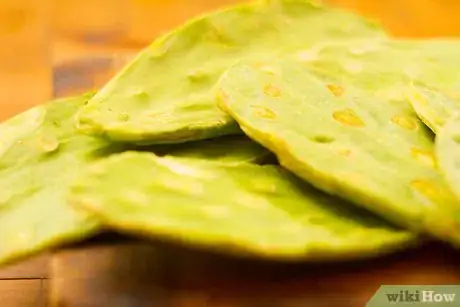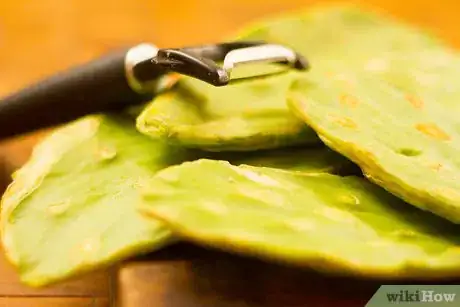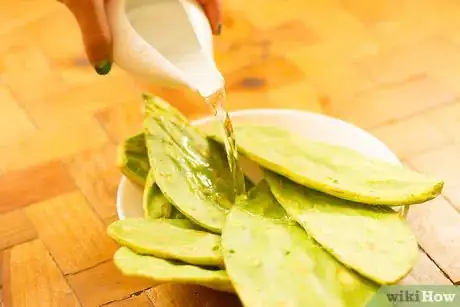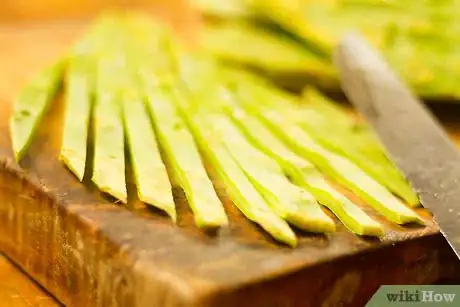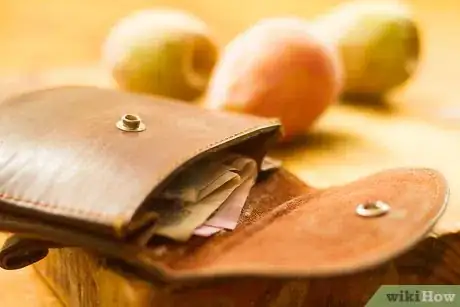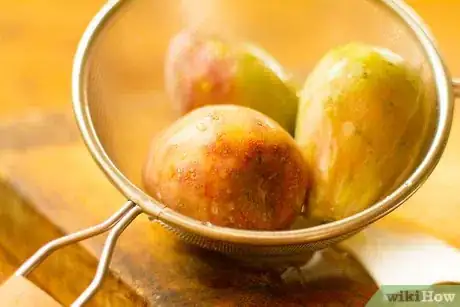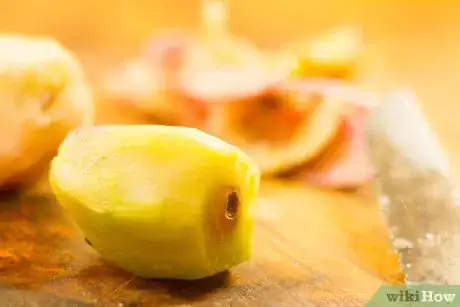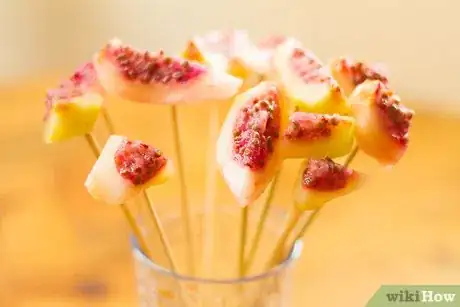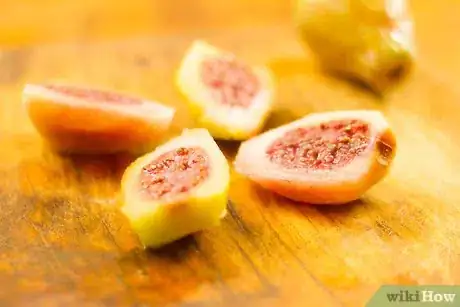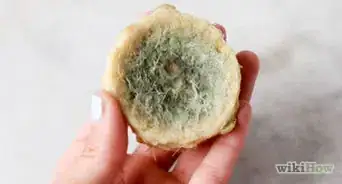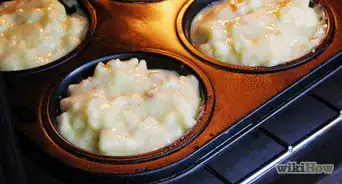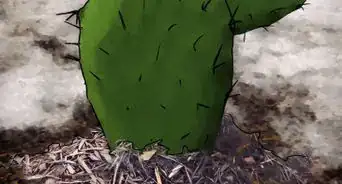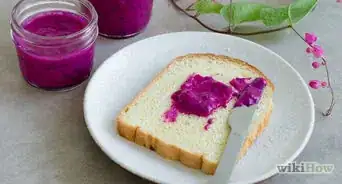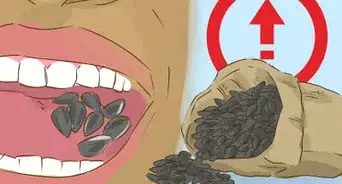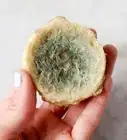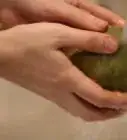wikiHow is a “wiki,” similar to Wikipedia, which means that many of our articles are co-written by multiple authors. To create this article, 66 people, some anonymous, worked to edit and improve it over time.
There are 7 references cited in this article, which can be found at the bottom of the page.
wikiHow marks an article as reader-approved once it receives enough positive feedback. This article received 27 testimonials and 92% of readers who voted found it helpful, earning it our reader-approved status.
This article has been viewed 1,644,983 times.
Learn more...
Prickly pear cactus has been a staple of the Mexican and Central American diet for thousands of years. In parts of the U.S. it has been gaining popularity as an exotic, gourmet and healthy addition to one's diet. The prickly pear plant has three different edible sections: the pad of the cactus (nopal), which can be treated like a vegetable, the petals of the flowers, which can be added to salads, and the pear (tuna), which can be treated like a fruit. They grow wild throughout the American southwest, down to South America and up to Canada. The ones you may find at a local store or farmers market will surely originate from a commercial nopal farm.
Ingredients
- Nopales (prickly pear pads)
- Prickly pear (the fruit of the cactus)
- Pepper, salt, other spices
Steps
Pads or Nopales
-
1Buy or forage some prickly pear pads. See Warnings. There's a reason it's called the prickly pear cactus.
- Find pads that are bright green and firm.
- Small, young pads harvested in early spring are thought to be the most succulent, delicate in flavor, and have the fewest spines. The thicker a pad, the older it is. Older pads tend to be stringy and their sap will be thicker, which some people find unpleasant. Leave those for other species who use them as survival food during lean foraging seasons. The tender pads are sometimes sold as "baby nopales".
- If you're harvesting them yourself, wear extremely heavy gloves or use tongs. Snap the pads off the plant or cut at the stem. Cutting at the stem reduces stress on the pad, and allows the cactus to recover more quickly than snapping or tearing the pad away. This helps keep your cactus plant healthy for future harvests.
-
2Remove the spines from the pad by using a vegetable peeler or a paring knife.[1] Don't take off the gloves until the pads are completely rinsed and the peeled remnants are cleared. The pads not only have large spines, but there are also tiny, invisible and far more irritating spines called glochids that are extremely difficult to remove from the skin. The spines and glochids can also be removed from the prickly pear pads by burning them off with a small torch or by placing the pad on a gas burner and turning it with tongs. See Warnings.Advertisement
-
3Run the pad under cool water. Peel or cut off any discolorations or bruises.
-
4Slice or cut the pads (wipe the knife blade after each slice, as there can be small spines sticking to it), or leave them whole, depending on what you will be using the nopales for.
-
5Cook the nopales. They can be either boiled or grilled, as well as mixed with other ingredients to make unique, satisfying and healthy dishes.[2]
- If you boil the nopales, you may sometimes have to drain and re-boil them once or twice, depending on how thick the sap is. The thicker the pad, the thicker the sap.
- Boiling them with a copper coin (an old Mexican "veinte") is a common remedy to thin the sap and make it more palatable to unaccustomed diners.
- The boiled nopales are then drained, washed off with cold water and served as a salad with finely diced tomatoes, onion, cilantro and jalapeños and seasoned with vinegar, salt and lime juice.
- If you grill the nopales, you might want to coat generously with pepper, salt, and other spices. They're ready when they're tender and slightly browned.
- Grilled nopalitos strips can be seasoned with fresh lime juice and a little olive oil. You can also add grilled portobello mushrooms to the mix.
- Try stirring the cooked nopales into soup, mixing them into a salad or omelet, pickling them, or eating them alone.
- A popular and traditional Mexican dish is "nopalitos en salsa verde", where the nopales are cut in strips and boiled in water (see above), and then re-cooked in the traditional sauce made of tomatillos (which are sometimes mistaken for green tomatoes, but are actually a completely different fruit that grow in a papery husk), onion, garlic, cilantro and jalapeño chiles (puree the sauce ingredients in a blender and then bring to a boil and simmer). This is usually eaten in a soft tortilla as a taco or with chips.
Prickly Pear
-
1Buy or harvest some prickly pears.[3]
- The pears with the reddish-orange or purple skin and deep purple interiors are considered to be the sweetest, but the white-skinned varieties are more popular in Mexico.
- Store-bought prickly pears are usually spine-free and sometimes can be handled with your bare hands. Unprocessed pears still have glochids that will drive you crazy if you get some on your skin. Just to be sure, always use tongs or at least a plastic bag as a glove.
- If you're foraging for prickly pears, remember that while all pears are edible, only a few will actually be ripe and taste good. Get them when they are bright purple and look like rat food, just before starting to wrinkle.
-
2Remove the spines.
- Place the pears in a plastic colander five or six at a time under cold water. Swirl the pears around for about three or four minutes not bruising them. Doing this washes all the fine blond hairs away, now you can handle them prickly free.
-
3Skin the pears.[4]
- All the hairs gone slice off the thicker skin at both ends of the prickly pear (the bottom and the top). It takes a little practice to know how much to slice off. Generally, you want to take off the skin without getting at the seed-filled center.
- Cut lengthwise along the pear's top-bottom centerline just through the skin. Using that slit, use the knife to lever the skin and peel it off of the rest of the pear.
-
4Cut the pear into slices, or stick onto a fork or skewer and serve.
-
5Finished.
Community Q&A
-
QuestionAre all prickly pear cactus edible?
 wikiHow Staff EditorThis answer was written by one of our trained team of researchers who validated it for accuracy and comprehensiveness.
wikiHow Staff EditorThis answer was written by one of our trained team of researchers who validated it for accuracy and comprehensiveness.
Staff Answer wikiHow Staff EditorStaff AnswerAll prickly pears (cacti in the genus opuntia) are edible, though you may find that many varieties are not as tasty, have more spines or seeds than the prickly pears and cactus pads you can find in stores.
wikiHow Staff EditorStaff AnswerAll prickly pears (cacti in the genus opuntia) are edible, though you may find that many varieties are not as tasty, have more spines or seeds than the prickly pears and cactus pads you can find in stores. -
QuestionWhat kind of cactus can you eat?
 wikiHow Staff EditorThis answer was written by one of our trained team of researchers who validated it for accuracy and comprehensiveness.
wikiHow Staff EditorThis answer was written by one of our trained team of researchers who validated it for accuracy and comprehensiveness.
Staff Answer wikiHow Staff EditorStaff AnswerAll prickly pear varieties are edible, saguaro cactus fruit is edible (though not easy to come by), organ pipe cactus and barrel cactus fruit is edible, as is dragon fruit, which grows on a cactus. There are several other types of cactus which are eaten throughout the world, but these are some of the most common.
wikiHow Staff EditorStaff AnswerAll prickly pear varieties are edible, saguaro cactus fruit is edible (though not easy to come by), organ pipe cactus and barrel cactus fruit is edible, as is dragon fruit, which grows on a cactus. There are several other types of cactus which are eaten throughout the world, but these are some of the most common. -
QuestionCan you eat prickly pear cactus raw?
 wikiHow Staff EditorThis answer was written by one of our trained team of researchers who validated it for accuracy and comprehensiveness.
wikiHow Staff EditorThis answer was written by one of our trained team of researchers who validated it for accuracy and comprehensiveness.
Staff Answer wikiHow Staff EditorStaff AnswerYes, both the pads and fruit can be eaten raw, just be sure to carefully remove the spines before eating if they haven't been removed.
wikiHow Staff EditorStaff AnswerYes, both the pads and fruit can be eaten raw, just be sure to carefully remove the spines before eating if they haven't been removed.
Warnings
- Some species of prickly pear cactus don't have spines, but all have glochids.⧼thumbs_response⧽
- Be very careful when removing the spines from the plant, or buy pads or pears that are already de-spined.⧼thumbs_response⧽
- Unless you wear extremely heavy gloves, it's best to handle the pads with tongs or some other "remote" device.⧼thumbs_response⧽
- Beware pear cactus can poke thorns through you and hurt really bad.⧼thumbs_response⧽
- If harvesting your own plants, always wear hand protection.[5]⧼thumbs_response⧽
References
- ↑ http://www.aihd.ku.edu/recipes/prickly_pear_cactus_pads.html
- ↑ https://www.mexicoinmykitchen.com/how-to-cook-cactus-paddles/
- ↑ https://www.simplyrecipes.com/recipes/how_to_cut_and_prepare_prickly_pears/
- ↑ https://www.motherearthnews.com/natural-health/herbal-remedies/eating-prickly-pear-ze0z1404zjhar
- ↑ https://tucson.com/lifestyles/food-and-cooking/tips-for-harvesting-and-preparing-prickly-pear-fruit/article_92bb3326-a618-59ae-890b-6bb88573c7cd.html
- https://www.desertusa.com/lil/lil_02.html
- https://www.mayoclinic.org/healthy-lifestyle/consumer-health/expert-answers/prickly-pear-cactus/faq-20057771
About This Article
If you want to eat the pads of a prickly pear cactus, make sure to wear heavy gloves or use tongs when you handle them, as the spines can prick you. Using a vegetable peeler or paring knife, remove both the large spines on the pads, as well as the tinier ones that might be hard to see. Once the spines are removed, rinse the pads in cool water. Then, slice the pads into strips, making sure to wipe your knife after each cut to remove any leftover spines. To cook the cactus pad strips, coat them generously with spices and grill them until tender and slightly browned. Consider tossing the grilled strips with fresh lime juice and a little olive oil for a tasty treat! To learn more, like how to eat the fruit of the prickly pear cactus, read on!
